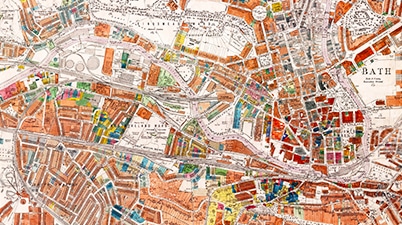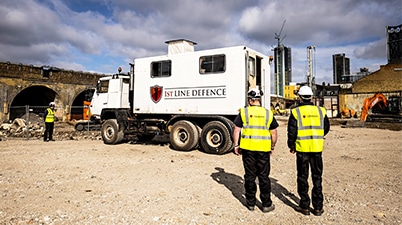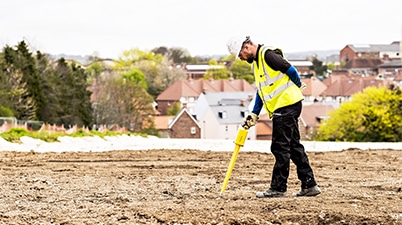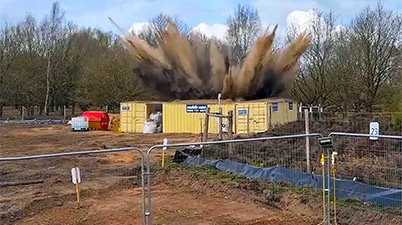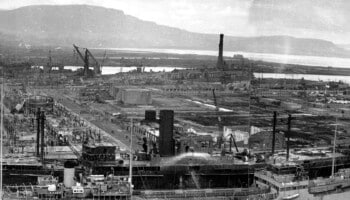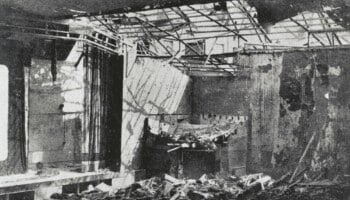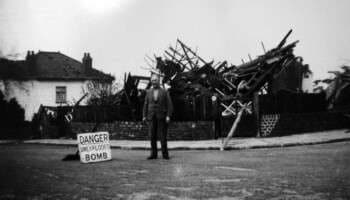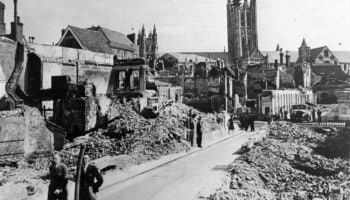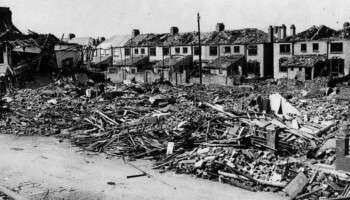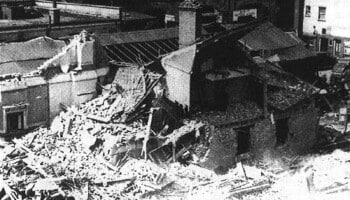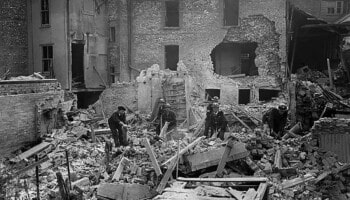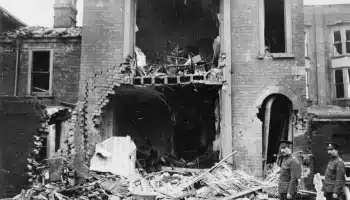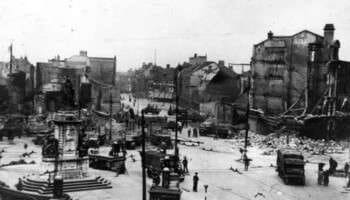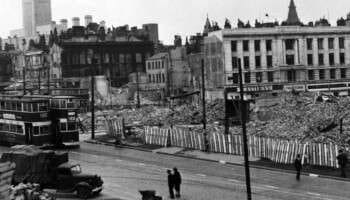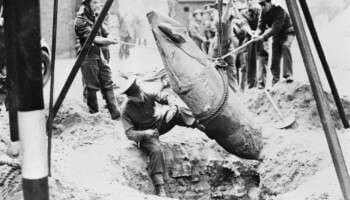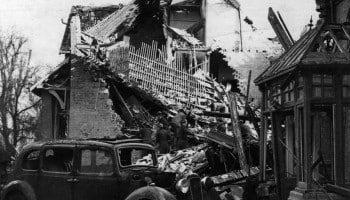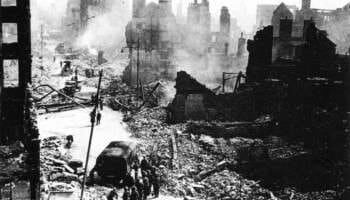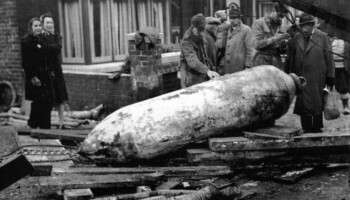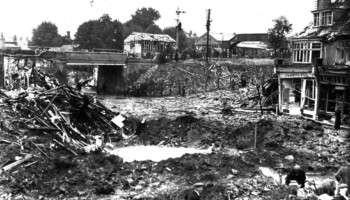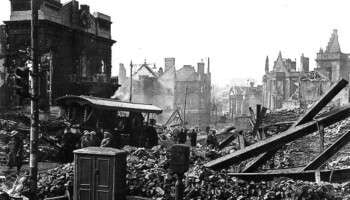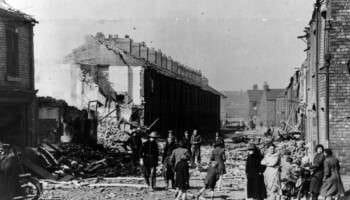Home » Resources » UXO City Guides »
UXO City Guide
Home Office Bombing Statistics for Birmingham
Record of German Ordnance dropped on the County Borough of Birmingham
High Explosive Bombs (All types)
4,359
Parachute Mines
49
Oil Bombs
82
Phosphorus Bombs
7
Fire Pots
3
Pilotless Aircraft (V-1)
0
Long-range Rocket Bombs (V-2)
0
Weapons Total
4,500
Area Acreage
51,147
Number of items per 1,000 acres
88
Why was Birmingham targeted and bombed in WWII?
Birmingham was an important industrial centre during WWII, producing munitions, aircraft and vehicles to aid the British war efforts. Many smaller workshops were involved in making items such as ammunition cases and grenades, as well as things like stirrup pumps for defence on the Home Front. Birmingham’s jewellers and silversmiths were well suited to use their specialist skills to produce component parts for rifles, aircraft and radar equipment. The city’s industries were crucial to the British war effort – a fact that was not lost on the German military.
Aerial photographs of factory sites were taken from civilian aircraft for the German intelligence services prior to the outbreak of war, and maps were gathered and annotated with named factories, hospitals, all major roads, railway lines, good yards, waterways and the electrical and telegraph grid. Birmingham had more key points than any other city outside London.
Home Office Bombing Statistics for Birmingham
Details obtained from the official Home Office bombing statistics, highlights the volume and type of bombs that fell on County Borough of Birmingham throughout WWII.
A total of 4,500 recorded bombs fell on Birmingham, equating to 88 items of ordnance per 1,000 acres.
Major bombing raids in Birmingham
There were three noticeable concentrations of key locations1:
- In the south-east, the Acocks Green/Sparkbrook/Tyseley district
- In the north-west, the Nechells/Castle Bromwich district
- In the north-west, the Smethwick/West Bromwich district
During the expansion of the Royal Air Forde (RAF) in the 1930s, the ‘shadow factory’ scheme was set up. Motor car manufacturers were seen as ideal to run such operations. UK car manufacturers Austin Motors took on a new factory at Cofton Hackett, Morris Motors produced Spitfires at a new plant in Castle Bromwich, and the Rover Company set up in Tyseley and Solihull to produce engines. Other car manufacturing factories were set up at Marston Green and Alcocks Green.
Although bombing occurred in Birmingham from August 1940, 19th-22nd November 1940 was to be ‘the most severe attack on Birmingham during the course of the Second World War2. Birmingham suffered three nights of consecutive bombing; 800 people lost their lives, 2,345 people were injured and 20,000 civilians were made homeless3.
The longest air raid of the ‘Birmingham Blitz’, lasting 13 hours, came on 11th December 19404, 263 people were killed and 243 badly injured after explosives and 25,000 incendiaries were dropped on the city causing widespread damage and destruction.
Birmingham became the third most heavily bombed city in England after London and Liverpool, with a total of 365 air raid warnings sounded in Birmingham and 77 recorded air raids throughout WWII. A total of 2,241 people were killed and 3,010 people were injured, whilst 12,391 houses and 302 factories were destroyed5.
Below is a copy of Birmingham Composite Air Raid Map obtained from the Library of Birmingham, which gives a visual indication of the high level of bombing sustained in the city.
Can UXO still pose a risk to construction projects in Birmingham?
The primary potential risk from UXO in Birmingham is from items of German air-delivered ordnance which failed to function as designed. Approximately 10% of munitions deployed during across the UK during WWII failed to detonate, and whilst efforts were made during, and after the war to locate and make UXBs safe, not all items were discovered. This is evidenced by the regular, on-going discoveries of UXO during construction-related intrusive ground works across the UK – not just in Birmingham.
This is true across the country, but especially in Birmingham where the level of bombing was so significant. Furthermore, a report from the November 1940 air raids, obtained from The National Archives, indicates that ‘bombing was so severe in the central districts that it was impossible to plot all the incidents on the map’ as later waves of bombers ‘dropped more bombs on the same targets’. This lack of comprehensive understanding of the full extent of bombing in Birmingham makes the area especially challenging when considering the potential for UXO to remain undiscovered.
I am about to start a project in Birmingham, what should I do?
Developers and ground workers should consider this potential before intrusive works are planned, through either a Preliminary UXO Risk Assessment or Detailed UXO Risk Assessment. This is the first stage in our UXO risk mitigation strategy and should be undertaken as early in a project lifecycle as possible in accordance with CIRIA C681 guidelines.
It is important that where a viable risk is identified, it is effectively and appropriately mitigated to reduce the risk to as low as reasonably practicable (ALARP). However, it is equally important that UXO risk mitigation measures are not implemented when they are not needed.
While there is certainly potential to encounter UXO during construction projects in Birmingham, it does not mean that UXO will pose a risk to all projects. Just because a site is located in Birmingham does not mean there is automatically a ‘high’ risk of encountering UXO. It really does depend on the specific location of the site being developed.
A well-researched UXO Risk Assessment will take into account location specific factors – was the actual site footprint affected by bombing, what damage was sustained, what was the site used for, how much would it have been accessed, what were the ground conditions present etc.
It should also consider what has happened post-war – how much development has occurred, to what depths have excavations taken place and so on. This will allow an assessment of the likelihood that UXO could have fallen on site, gone unnoticed and potentially still remain in situ.
Sources
1The Luftwaffe over Brum, Steve Richards
2https://www.birminghammail.co.uk/news/nostalgia/75-years-devastating-luftwaffe-raid-10469472
3https://www.birminghamhippodrome.com/hippodrome-projects/hippodrome-produced/festivals/birmingham-blitz-project/
4https://www.iwm.org.uk/collections/item/object/205198721
5Heroes of the Birmingham Air Raids: A Tribute to Birmingham’s Heroes 1940-1943 with Details of Medals Awarded, by Michael Minton
Recent UXO discoveries in Birmingham
Since the war, many items of UXO have been discovered across multiple cities within the UK, with Birmingham no exception. See the news articles below about UXO incidents and discoveries from national and local press in Birmingham.
1st Line Defence keep up-to-date with relevant and noteworthy UXO-related news stories reported across the UK, and you can browse through these articles using the buttons below.
Press articles 2025 Press articles 2024
Get UXO risk mitigation services from a partner you can trust
UXO City Guides
Got a project in Birmingham? Need advice but not sure where to start?
If you need general advice about UXO risk mitigation in Birmingham, contact us and we will be happy to help.
Contact Us
* indicates required fields
